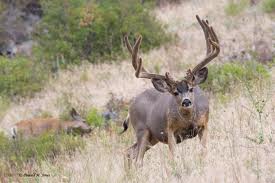If you can’t hit a running animal, you’re missing a lot of action.
Why is it shooting at a standing bird (ground sluicing) is considered un-sportsman like, while shooting at a running deer is un-ethical. For the life of me, I can’t see the difference.
Hitting running deer can be a daunting task even for experienced shooters. However, there are a few tricks, which will greatly improve your shooting performance at running deer.
There are two schools of thought on hitting running game with a high powered rifle. They are the
swing through and the
sustained lead.
Swinging through the deer is the same as swinging a shotgun at a flying bird. The hunter moves the cross-hairs through the target and squeezes the trigger when the cross-hairs pass the intended target.
Sustained lead is just that. The hunter leads the deer with his cross-hairs and hopes the deer runs into the bullet. Unfortunately, this rarely works out.
A rifleman with a good swing is about 5 times more successful at hitting running game than one using the sustained lead method.
Here’s how to master the swing:
Mounting the Rifle
One common mistakes most hunters make is properly mounting the rifle. The tendency is to bring the butt of the rifle up to your shoulder. The butt of the rifle can easily get hung-up on our heavier hunting jacket making it difficult to get a consistent mount. It’s best to practice pushing the rifle away from your body and then bringing it straight back to the shoulder. Good shooter practice their mount before they go to the range.
Gripping the Rifle
Learning to mount your rifle properly will ensure a good solid anchor of the rifle to your shoulder. Equally important is learning how to properly grip the forearm. A good shooter will extend their index finger and aline it with the barrel. Where the finger points, the barrel also points. This makes it a lot easier to follow the deer with the muzzle.
Trigger Pull
A good trigger pull will greatly improve your shooting at all game, moving or not. Factory triggers tend to be stiff, have excessive pull or both. A hunter should never have to force the trigger. If you have to put too much pressure on the trigger or there is too much slop in the pull, you’re likely to slow or even stop your swing causing a miss. The rifle should go off easily when the hunter wants it to. I like my hunting trigger to be crisp, with a pull between 2 and 3 pounds. Any gunsmith can help you adjust your trigger to the proper pull.
Swing and Follow Through
A good swing and follow through is a lot like playing baseball. The batter keeps his eye on the ball and doesn’t stop his swing when he hits the ball. He follows through. Likewise, a batter has to time his swing to make contact with the ball. If he gets excited and swings too fast or too slow, he’ll miss the ball all together. These same principle apply to shooting.
Our natural tendency is to stop the swing once the rifle goes off. This inevitably causes our shot to land behind the deer. If we swing too fast or try to speed up our swing, we’ll shoot in front of the deer. Practicing your swing and follow through is essential if you want to become an accomplished shot at running game.
It’s best to keep the rifle moving at the same speed as the deer and slowly increase the speed of the muzzle and squeeze the trigger when the cross-hairs pass through the deer.
Just like a batters focus is on the ball and not the bat, our focus should always be on the deer not the cross-hairs. If we shift our focus between the deer and the cross-hairs, our swing will be erratic and we’ll miss.
Hitting running deer isn’t easy. It never is. However, if you follow these four simple tricks, you’ll greatly improve your odds at hitting the running buck.
Jim






























+(4).jpg)



